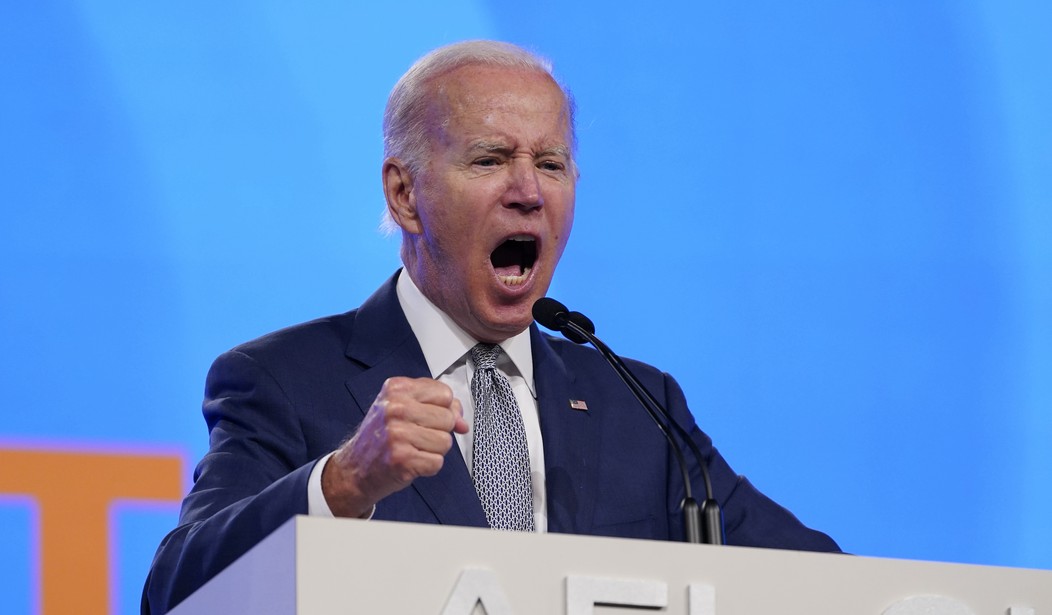Here’s a hint: It’s not the party of “incredible transitions” at the gas pump. More than a million voters have marched figuratively across the political transom in this midterm cycle, the Associated Press reports this morning. It’s not yet a case of voting with one’s feet, but it certainly gives the impression of it:
A political shift is beginning to take hold across the U.S. as tens of thousands of suburban swing voters who helped fuel the Democratic Party’s gains in recent years are becoming Republicans.
More than 1 million voters across 43 states have switched to the Republican Party over the last year, according to voter registration data analyzed by The Associated Press. The previously unreported number reflects a phenomenon that is playing out in virtually every region of the country – Democratic and Republican states along with cities and small towns – in the period since President Joe Biden replaced former President Donald Trump.
But nowhere is the shift more pronounced – and dangerous for Democrats – than in the suburbs, where well-educated swing voters who turned against Trump’s Republican Party in recent years appear to be swinging back. Over the last year, far more people are switching to the GOP across suburban counties from Denver to Atlanta and Pittsburgh and Cleveland. Republicans also gained ground in counties around medium-size cities such as Harrisburg, Pennsylvania; Raleigh, North Carolina; Augusta, Georgia; and Des Moines, Iowa.
The AP used a company with which I’ve worked in the past to do this research:
The AP examined nearly 1.7 million voters who had likely switched affiliations across 42 states for which there is data over the last 12 months, according to L2, a political data firm. L2 uses a combination of state voter records and statistical modeling to determine party affiliation. While party switching is not uncommon, the data shows a definite reversal from the period while Trump was in office, when Democrats enjoyed a slight edge in the number of party switchers nationwide.
But over the last year, roughly two-thirds of the 1.7 million voters who changed their party affiliation shifted to the Republican Party. In all, more than 1 million people became Republicans compared to about 630,000 who became Democrats.
L2 provided me an entry-level access to their services gratis while I wrote my book Going Red, and even the limited data I could access was impressive at the time. They have a great deal of data, mainly consumer info but also on politics, that allows for this kind of granular analysis. This goes way beyond polling, and one should take these numbers very seriously.
We should also keep them in perspective. A net gain of a million voters in a midterm cycle is probably not dispositive in and of itself. The 2018 midterm cycle had a big turnout of 49.4% of eligible registered voters, the highest percentage in more than a century. Over 110 million people voted in those midterms, and thanks to early voting and another electorate energized by an unpopular president, we might see something close to that this time around, too. One million votes is less than 1% of that turnout.
But even if turnout in 2022 drops down to more of the historical norm for midterms, the level of change in voter registration won’t in and of itself make a big impact on 435 House races. It might have a bigger impact on 35 Senate races, depending on where those gains are distributed, but even then the direct effect is likely to be marginal.
However, this isn’t about the direct impact as much as it is a signal of the direction of the overall electorate. Just as it did four years ago, this massive migration to the GOP signals that voters have grown extremely dissatisfied with the single-party rule of the incumbents. It’s a stronger signal than recent special elections, in fact, because this speaks to identity on a more permanent basis than just a momentary level of dissatisfaction. This data suggests a realignment in progress — a realignment at a relatively modest scale thus far, but one that might gain momentum if Joe Biden doesn’t shift directions dramatically after the midterms.
Of course, anything can happen. The Dobbs decision and the end of Roe might shift some of this back toward Democrats, but … that seems unlikely. The contours of Democrats and Republicans on abortion are already well known and both represent the purists on either end of the spectrum. Anyone who’s a true believer in abortion rights to the point of casting protest votes over Dobbs wouldn’t be switching to the GOP in the first place. This mass migration shows discontent over issues much more integral to American households, and that’s not going to change much in the next four months. Unfortunately.
Addendum: Those January 6 committee hearings are turning out to be a bust, eh?
Update: I inadvertently left out the link to the AP report. It’s in the first paragraph now.









Join the conversation as a VIP Member